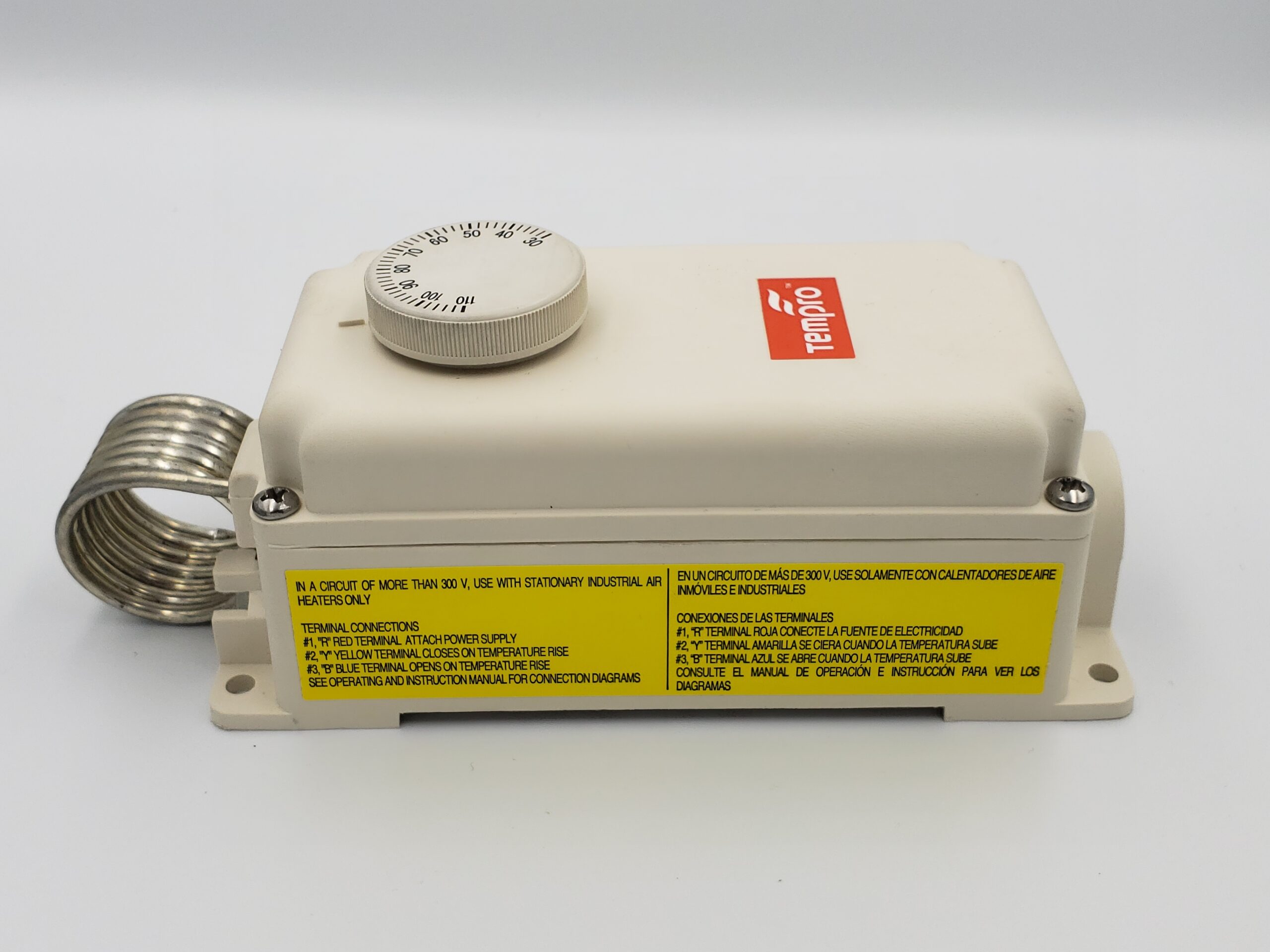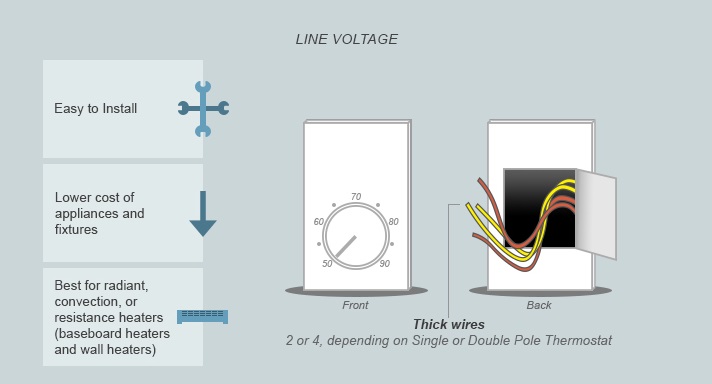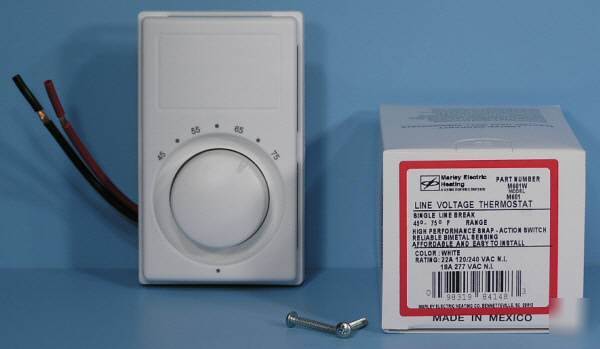What Is A Line Voltage Thermostat

What is a Line Voltage Thermostat? A Comprehensive Guide to Saving Energy and Money
If you're looking to cut down on energy bills and create a more comfortable, energy-efficient living or working space, understanding your heating and cooling system is crucial. One often-overlooked component is the thermostat. This article delves into the specifics of line voltage thermostats, explaining what they are, how they differ from low voltage thermostats, their pros and cons, and how they can contribute to significant energy savings.
Understanding the Basics: Line Voltage vs. Low Voltage
At its core, a thermostat's job is simple: sense the ambient temperature and control your heating or cooling system to maintain your desired setting. However, the way they achieve this varies considerably. The primary distinction lies in the voltage they use to communicate with the HVAC equipment.
Line voltage thermostats operate on the same voltage as your building's electrical supply – typically 120V or 240V in North America. This means they directly switch the power to the heating system, like electric baseboard heaters, radiant floor heating, or electric furnaces. Think of them as heavy-duty switches that handle the full electrical load. Because of this direct connection, they are often found in systems that don’t require a central control panel or complex wiring schemes.
Low voltage thermostats, on the other hand, use a lower voltage, usually 24V, to control the HVAC system. They don’t directly switch the power; instead, they send a signal to a central control board that then activates the heating or cooling equipment. This type is commonly found in central heating and cooling systems (furnaces, air conditioners, heat pumps) that have more complex control mechanisms.
The key difference is the voltage level and how directly the thermostat controls the heating or cooling equipment.
Identifying a Line Voltage Thermostat
Knowing which type of thermostat you have is the first step to upgrading or troubleshooting your system. Here are a few telltale signs of a line voltage thermostat:
- Wiring: They typically have only two or four thick wires connected to them. These wires are usually labeled L1, L2 (for 240V systems), and sometimes N (neutral) and Ground.
- Application: Common applications include electric baseboard heaters, wall heaters, and radiant floor heating systems.
- Physical Size: They may be larger and more robust than their low voltage counterparts due to the need to handle higher currents.
- No Central Control: If your thermostat controls a single heating unit directly, without a central furnace or AC unit, it's likely a line voltage thermostat.
Important Safety Note: Working with line voltage electricity can be dangerous. Always turn off the power at the circuit breaker before attempting any wiring or maintenance. If you are uncomfortable working with electricity, consult a qualified electrician.
Pros and Cons of Line Voltage Thermostats
Like any technology, line voltage thermostats have their own advantages and disadvantages. Understanding these will help you determine if they are the right choice for your application.
Pros:
- Simplicity: They are relatively simple to install and troubleshoot due to their straightforward wiring.
- Direct Control: They offer direct control over the heating element, resulting in quick and responsive temperature adjustments.
- Cost-Effective (Initial): Basic models are often less expensive to purchase than more complex low voltage systems.
Cons:
- Limited Features: Older models often lack advanced features like programmable schedules or smart home integration.
- Lower Energy Efficiency (Historically): Traditional line voltage thermostats might not be as precise in temperature control, leading to potential energy waste. However, newer digital and smart models are closing this gap.
- Safety Concerns: Working with high voltage electricity requires caution and expertise.
- Zoning Challenges: Implementing sophisticated zoning systems can be more complex with traditional line voltage thermostats, though modern smart models are improving in this area.
The Rise of Smart Line Voltage Thermostats: Energy Savings and Convenience
The landscape of line voltage thermostats is rapidly evolving. The introduction of smart line voltage thermostats has addressed many of the limitations of older models, offering significant improvements in energy efficiency, convenience, and control.
Key Features of Smart Line Voltage Thermostats:
- Programmable Schedules: Set different temperatures for different times of the day to optimize energy usage based on your occupancy patterns.
- Remote Control: Adjust your thermostat from anywhere using a smartphone or tablet.
- Learning Algorithms: Some models learn your heating preferences and automatically adjust the schedule to maximize comfort and energy savings.
- Energy Usage Monitoring: Track your energy consumption to identify areas for improvement.
- Smart Home Integration: Connect to other smart home devices and platforms (like Amazon Alexa, Google Assistant, or Apple HomeKit) for seamless automation.
- Geofencing: Automatically adjust the temperature when you leave or approach your home.
ROI and Energy Savings:
Investing in a smart line voltage thermostat can yield significant returns. Studies have shown that programmable thermostats can save homeowners up to 10-15% on their heating bills. Energy Star estimates that properly using a programmable thermostat can save approximately $180 per year. The actual savings depend on your location, heating habits, and the efficiency of your heating system.
Furthermore, many utility companies offer rebates and incentives for installing energy-efficient thermostats. Check with your local utility provider to see what programs are available in your area. These rebates can significantly reduce the initial cost of upgrading to a smart thermostat, further accelerating your ROI.
Installation and Wiring Considerations
While installing a line voltage thermostat is generally straightforward, it's essential to proceed with caution and follow proper safety procedures.
- Turn off the Power: Always disconnect the power at the circuit breaker before starting any electrical work.
- Verify Voltage: Confirm the voltage of your heating system (120V or 240V) and ensure that the thermostat you are installing is compatible.
- Follow the Wiring Diagram: Carefully follow the wiring diagram provided with the thermostat. Incorrect wiring can damage the thermostat or create a fire hazard.
- Use Appropriate Wire Connectors: Use properly sized wire connectors to ensure secure and safe connections.
- Test the Installation: After completing the wiring, carefully inspect your work and turn the power back on. Test the thermostat to ensure it is functioning correctly.
If you are not comfortable working with electricity, it's always best to hire a qualified electrician or HVAC contractor to perform the installation.
Choosing the Right Line Voltage Thermostat for Your Needs
With a wide variety of line voltage thermostats available on the market, selecting the right one for your needs can feel overwhelming. Here are some factors to consider:
- Heating System Compatibility: Ensure that the thermostat is compatible with your specific heating system (e.g., electric baseboard heater, radiant floor heating).
- Voltage: Choose a thermostat that matches the voltage of your electrical system (120V or 240V).
- Features: Consider the features that are important to you, such as programmable schedules, remote control, smart home integration, and energy usage monitoring.
- Ease of Use: Opt for a thermostat with a user-friendly interface and intuitive controls.
- Budget: Set a budget and compare prices from different manufacturers and retailers.
- Reviews: Read online reviews from other users to get an idea of the thermostat's performance and reliability.
Popular brands of smart line voltage thermostats include Mysa, Sinope, and Aube. Research these brands and compare their features to find the best fit for your needs.
Conclusion: Embrace Energy Efficiency with Line Voltage Thermostats
Line voltage thermostats play a crucial role in controlling electric heating systems. While traditional models may have limitations, the advent of smart line voltage thermostats has opened up new possibilities for energy savings, convenience, and control.
By understanding the differences between line voltage and low voltage thermostats, considering the pros and cons of each type, and exploring the benefits of smart technology, you can make informed decisions that will help you reduce your energy bills, improve your comfort, and contribute to a more sustainable future. Whether you are a homeowner, a business owner, a smart home enthusiast, or an HVAC contractor, embracing energy-efficient solutions like smart line voltage thermostats is a win-win for everyone.
Remember to always prioritize safety when working with electricity and consult a qualified professional if you have any questions or concerns. By taking a proactive approach to energy management, you can create a more comfortable, efficient, and sustainable living or working environment.







/wire-a-baseboard-heater-thermostat-1152658-hero-7bc79b44cdab4594bc1915ede0c943f5.jpg?strip=all)


